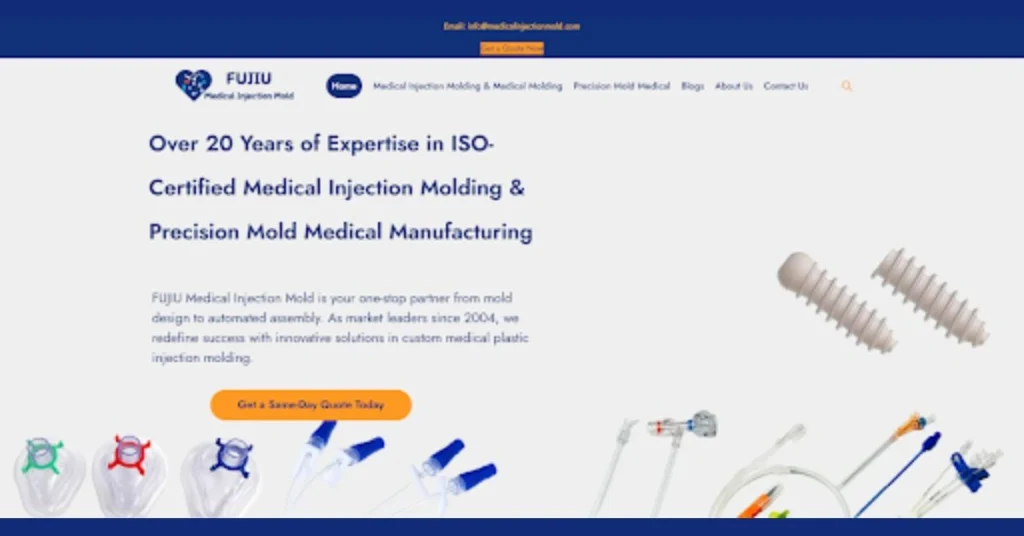Contents
key steps
FUJIU Medical Injection Mold offers comprehensive solutions to help maintain Precision Mold Medical, providing expert guidance on mold care, cleaning, and inspection. With their advanced knowledge and commitment to quality, FUJIU ensures that molds operate at peak efficiency, ultimately enhancing the overall performance and reliability of medical device manufacturing.
Maintaining Precision Mold Medical is crucial for ensuring that medical devices produced via Medical Injection Molding meet high accuracy, quality, and safety standards. These molds are designed to manufacture components for medical products that require strict regulatory compliance and superior performance. Proper mold maintenance not only extends the life of the molds but also reduces downtime, minimizes defects, and ensures cost-effective production. Here are key steps to properly maintain Precision Mold Medical:Here are key steps to properly maintain Precision Mold Medical:
Regular Cleaning
Cleaning is one of the most important aspects of mold maintenance. Medical injection molds, especially Precision Mold Medical, need to be cleaned regularly to ensure that no contaminants, debris, or leftover materials interfere with the molding process. These contaminants can cause defects in the molded components, resulting in wasted materials and increased costs.
- Cleaning Process: Use soft brushes, cleaning solutions, and compressed air to clean the mold cavity. Avoid using harsh chemicals or abrasive materials that could damage the mold’s surface or alter its dimensions.
- Lubrication: Apply appropriate lubricants to the moving parts of the mold, such as ejector pins and slides. This prevents wear and tear, reducing friction and ensuring smooth operation.
Inspection for Wear and Damage
Regularly inspect the Precision Mold Medical for signs of wear, cracks, or damage. Over time, molds can suffer from erosion, stress, or mechanical failure, which can impact the quality of the molded components.
- Inspection Checklist: Check for signs of wear on critical areas such as the cavity, core, and ejector system. Look for any signs of rust, corrosion, or physical damage.
- Visual Inspection: Use magnifying tools to check for any cracks or chips in the mold that could affect the production process.
- Maintenance Records: Keep a log of any wear or repairs performed, as well as the frequency of inspections. This will help identify patterns and schedule more frequent maintenance when necessary.
Preventive Maintenance
Preventive maintenance is an essential part of mold care and helps avoid costly repairs. Regular preventive maintenance can ensure that Precision Mold Medical performs optimally and extends its lifespan.
- Timing: Set a schedule for routine maintenance based on mold usage, production cycles, and material type. Preventive maintenance should be carried out after a certain number of production cycles or at scheduled intervals.
- Temperature Control: Maintaining proper temperature during the molding process is crucial. Precision Mold Medical molds can be sensitive to temperature fluctuations. Ensure that the mold temperature is kept within the recommended range to prevent thermal expansion or contraction, which can lead to misalignment or defects.
- Cooling System: Regularly inspect and clean the mold’s cooling system. Ensure that there are no blockages in the cooling channels, as proper cooling is essential to prevent overheating and mold degradation.
Maintenance of Moving Parts
Molds often contain moving components, such as slides, cores, and ejector pins. These parts are subject to wear and need to be properly maintained to ensure smooth functioning during production.
- Lubrication: Regularly apply the right lubricant to moving parts. Choose lubricants that are compatible with the mold material and won’t leave residue or react with the molded material.
- Alignment: Ensure that all moving parts are aligned correctly to avoid uneven wear and improve mold efficiency. Misalignment can cause sticking, improper ejection, and increased friction, leading to premature mold wear.
Check Mold Alignment
Correct alignment of all mold components is essential for producing high-quality medical devices. Misalignment can result in defects such as flash, parting lines, or inconsistent molding. Precision Mold Medical requires careful attention to alignment during both setup and maintenance.
- Regular Adjustment: Inspect and adjust mold components, such as the cavity and core, to ensure proper alignment. This should be done during routine inspections or if defects appear in the produced parts.
- Quality Control: Ensure that any misalignment or shifts in mold components are corrected before production resumes. Using measurement tools and gauges can help verify mold alignment and prevent inconsistencies in output.
Maintain Mold Temperature Control
Maintaining the proper temperature in Precision Mold Medical is crucial for producing medical components with high accuracy and consistency. Temperature control ensures that the material is injected at the right viscosity and that cooling occurs at the correct rate to prevent warping and distortion.
- Regular Checks: Inspect the mold’s heating and cooling systems for any signs of malfunction. Ensure that the temperature control system is functioning properly, and clean any clogged temperature control channels.
- Maintain Consistency: Consistent mold temperature during production ensures uniform cooling, which leads to improved part quality and mold longevity.
Repairing Mold Damage
Despite regular maintenance, molds may experience damage due to heavy use or external factors such as material-related issues. If Precision Mold Medical sustains any damage, it is important to repair it promptly to prevent defects in future production.
- Timely Repairs: Address any damage or wear as soon as it is noticed. Minor repairs, such as polishing cavities or replacing worn-out pins, can prevent more costly and complex repairs down the line.
- Professional Repair Services: For severe damage or issues that cannot be repaired in-house, consider professional repair services specializing in mold restoration and precision engineering. These services can restore molds to their original performance standards.
Documentation and Record-Keeping
Keeping detailed records of mold maintenance, repairs, and production history is essential for tracking the performance and lifespan of Precision Mold Medical. This helps identify recurring issues and supports better decision-making when it comes to mold upgrades or replacement.
- Maintenance Logs: Document every cleaning, inspection, repair, and part replacement done to the mold. These records should include the date, the technician involved, and the work performed.
- Usage Records: Keep track of the number of cycles the mold has undergone. This information can be valuable in determining when the mold is due for maintenance or replacement.

